June 30, 2025
Summer Trips for 2025
Part of our Summer Travel Series
By Leonard Chan and Claire Yi
This is our 11th edition of our AAPI related summer travel series (here are links to our prior articles – 2005, 2006, 2007, 2008, 2009, 2010, 2021, 2022, 2023, and 2024; note: some of the links from these articles are broken, but you can still find most of these places by doing an online search).
Here are some places to check out in 2025.
------------------
Charles Wong Collection at the Museum of Modern Art in San Francisco
By Claire Yi
At the SFMOMA, I had the privilege of viewing selections from Charles Wong’s work, featuring his photographic essay titled “Year of the Dragon”. They are from 1952, consisting of scenes around San Francisco’s Chinatown. The collection is in one of the front rooms next to the ticket counter.
Charles Wong was born in Chinatown, serving in World War II before working as a steel engineer at Bethlehem Steel and Bechtel Corp. He studied photography at the California School of Fine Arts under well-known photographers including Imogen Cunningham and Ansel Adams. Although his photography career was short-lived, his art has been displayed at the de Young Museum, Princeton Art Museum, and in Aperture Magazine. “Year of the Dragon” explores the generational changes of immigrants despite living within the same streets of Chinatown.
My favorite pieces from this collection were Internal Medicine and a set of floral pictures. Internal Medicine shows a plumbing advertisement in both Chinese and English with a Chinese medicine sign around the corner. The floral set shows a child looking at the car window at pinwheels, and the adjacent photo shows a woman wearing a qipao while holding a quince tree. In an interview with Cailee Milner, Wong stated:
They looked fabulous, and I couldn’t get over how satisfied she was with her quince. The gentleman’s looking at his plant – he’s thinking about putting it in a porcelain pot. It’ll grow the next year and the year after that. He’s looking at the future, and she’s thinking about how her flower’s going to bloom the next day. The whole concept of Chinese New Year is in this image.
Even though it’s the middle of summer, I would highly recommend visiting this New Year selection. The room also featured a breathtaking painting by Martin Wong, titled “Chinese New Year’s Parade.” He was a Chinese-American painter who also grew up in San Francisco. If you are not able to visit SFMOMA, here are links to both Charles’s and Martin’s work:
San Francisco MOMA's website for Charles Wong
San Francisco MOMA's web page for the Martin Wong painting
For more information on Charles Wong:
San Francisco Chronicle Article on Charles Wong
Google Map to San Francisco Museum of Modern Art (SFMOMA)
------------------
San Francisco Comfort Women Memorial
By Claire Yi
I was headed to meet a friend for coffee, but decided to stop at this memorial along the way. The memorial shows three women holding hands, representing China, Korea, and the Philippines; it is a solemn display of World War II history. The term “comfort women” describes the women and girls that suffered in sexual exploitation under the Imperial Japanese Armed Forces. The monument was first made public in 2017 to educate and spread awareness about trafficking that still persists today.
The denial of these crimes led to the formation of the Comfort Women Justice Coalition, along with many activists over the years demanding justice in the face of the Japanese government’s denial. Over 400,000 women and girls were forced into servitude with an estimated fatality rate of 90%. The denialism has even incited Osaka’s mayor, Hirofumi Yoshimura, to cut ties with San Francisco as its sister-city after the formal dedication of the statue. San Francisco insists that the statue shall remain standing. Retired Superior Court judge Lillian Sing said that “[Yoshimura] wants to remove the memorial because he is afraid of the truth.”
Seeing it in person evokes strong emotions of justice, sadness, and anger. The statue is also a stark reminder of why I chose to study history; a professor’s month-long lecture series on Imperialist Japan had moved many students, including myself, to tears. These stories must be told, and it is our duty to learn from the past to prevent future atrocities. It is located in St. Mary’s Square at 651 California Street.
For more information:
Directions to finding the monument
Article -"Comfort Women" and the US Pivot to Asia
New York Times article on San Francisco Comfort Women Monument
------------------
Pacific Grove Museum of Natural History (Chinese Fishing Village Exhibit)
By Leonard Chan
On a recent trip to Monterey, I was looking for places to visit. When I looked at the Pacific Grove Museum’s website, I found an exhibit that interested me.
There was a book that AACP used to carry called “Chinese Gold: the Chinese in the Monterey Bay Region.” I never had the chance to read the book, but from it, I knew that Chinese people had a long history in that region. Just how far back, I didn’t know and how they got there was also a mystery. I had imagined that they were just some gold miners that had become disillusioned and went back to what they were used to doing, namely fishing.
This could have been the case for some of them, but what I learned was that a number of them had actually traveled to California in their own ships. These early Chinese immigrants ended up being among the first to recognize the vast fishing potential of the Monterey area.
Along with the wonderful informational panels for this exhibit is a meticulously crafted miniature diorama created by local artist, Michael Croft, who based his model on photos of the village. With the diorama of the village is a model of an ocean going Chinese junk that could have been used to sail to America.
What made this Chinese community unique was that Chinese families had immigrated to the region and not just male laborers as more commonly portrayed in some history text. One of the things that I learned was that some Chinese in the community could trace their heritage back seven generations.
The museum’s website contains a curriculum for grades K-8, that has a classroom kit, booklet for students, and videos that can be seen by all (click here to get to that web page).
Another thing to see in the area, that I did not get to find, are some markers along the walkway between Pacific Grove and Monterey that indicated the location of the Chinese fishing village. I was told that it was near the Monterey Bay Aquarium. So on my next visit to the area, I’ll be sure to look for them. You can too.
Google Map to Pacific Grove Museum of Natural History
------------------
Arboga Assembly Center Memorial Site (location of the Marysville Assembly Center)
By Leonard Chan
I was just watching a news story about a makeshift detention center being built to house immigrant detainees in Florida (“Alligator Alcatraz”). When I saw this, I began to think about the “Assembly Centers” used to temporarily house Japanese American detainees during World War II. (note: for those that may have stumbled upon this article, I use Japanese American to describe all the detainees even though a good portion were not US Citizens; at that time, Asian immigrants were not allowed to become naturalized citizens.)
There were fifteen “assembly center” camps used to hold the Japanese Americans and they were only held there for a short period before they were sent on to larger and more permanent internment camps. Most of these assembly centers were closer to cities and towns, not like the larger internment camps that were often out in desolate areas. Many of these assembly centers were located on already built places, like race tracks and fair grounds. In the case of Arboga, it had been a migrant farm workers’ camp near the Feather River.
I had heard about the Marysville Assembly Center from my friend Mas Hongo (long time key volunteer with AACP) who was one of the detainees held there before moving on to Tule Lake. Marysville is not far from my dad’s home town of Oroville, so my family would often pass through Marysville on our way to Oroville. On a recent trip to Oroville, I decided to check out what was at Arboga.
Like a number of the former assembly center locations, Arboga has a memorial to remember those that were held at that site. Arboga’s memorial was created by Yuba Sutter Arts & Culture (a local nonprofit arts and culture organization) in collaboration with the Marysville Japanese American Citizens League.
I have been to two Japanese American World War II incarceration camps (Tule Lake and Poston) and have seen the monuments erected at those sites. Arboga’s memorial was different. At this site, you will see large portrait photo of some of those that were interned at that camp. Most of these photos were taken by a local portrait photographer who, for some unknown reason, had the opportunity to take them (watch the interesting video story made by Bay Area CBS station KPIX).
Among the photos at this site, was a large photo of Hiroshi Kashiwagi (AACP published three of his books). Hiroshi was another friend that was detained at this site. I was not expecting to see his photo nor the accompanied words that he wrote describing Arboga. It was as if he were there, telling me about the place.
The photos added a real personal touch to this memorial, especially for me, since I knew one of the people in these photos. In some way, the photos brought a spiritual presence to this quiet farm field.
The art installation at Arboga was equally unique. In the absence of actual standing buildings from that camp, there was a three panel metal monument that symbolically represented a camp barrack. The panels had cutouts which emblematically indicated the location of Arboga.
Along with the large photos and central barrack monument, there were plaques and boards indicating information about the location.
If you should be on a journey through the northern part of California’s Central Valley, take the slight detour to visit this site and to remember.
For more information visit the Yuba Sutter Arts & Culture web page for this memorial site.
Google Map to this memorial site
-----------------
Photos taken at the Pacific Grove Museum of Natural History
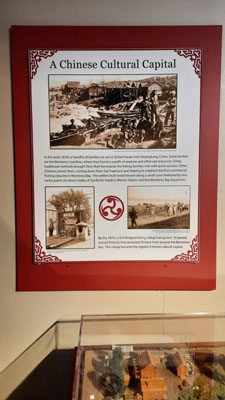
Sign describing the founding of the fishing village.
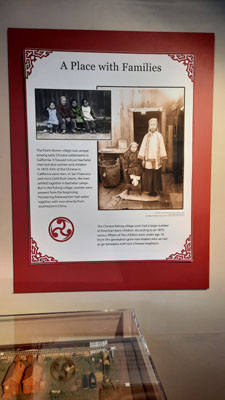
Description of how this community was unusual since it had more families.
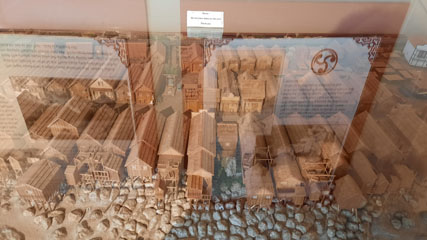
First location of the fishing village at Point Alones before it was burned down in 1906.
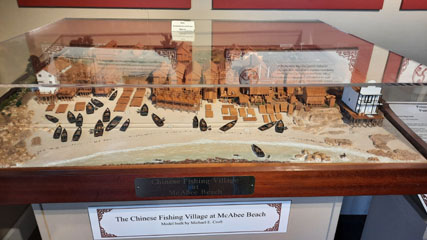
Second location of the fishing village at McAbee Beach.
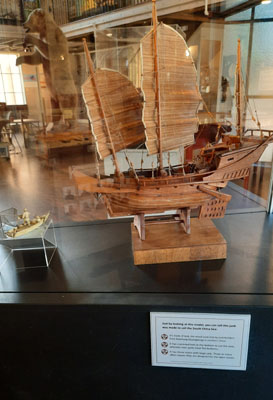
Model of an ocean going Chinese junk, thought to be similar to the ones used by the travelers that sailed to Monterey Bay from China.
Photos Taken at the Arboga Assembly Center Memorial Site
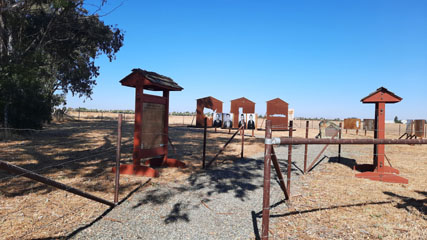
Entry to the Arboga Assembly Center Memorial Site. Large photos and barracks art can be seen in the middle of the photo.
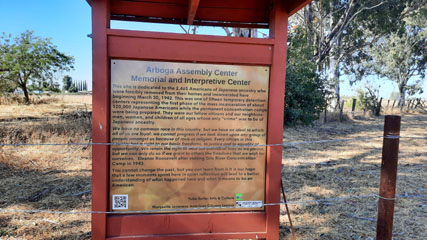
Entry Sign
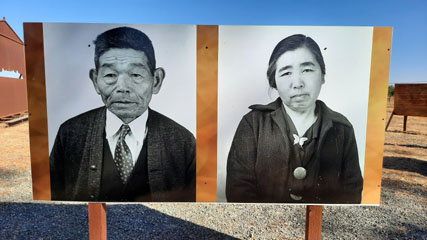
Two of the large photos placed around the memorial site.
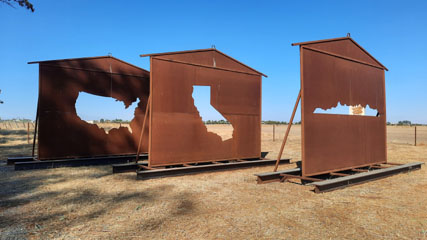
Symbolic barrack art installation. The cut outs represent the location of Arboga. The cut out on the panel on the right represents the near by Sutter Buttes.
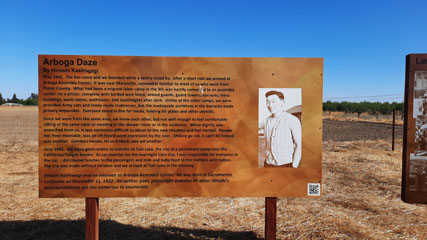
Panel containing description of Arboga written by author, poet, and playwright Hiroshi Kashiwagi.
Copyright © 2025 by AACP, Inc.